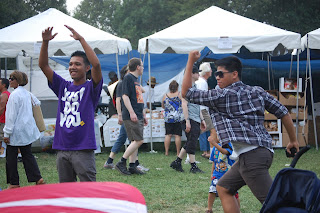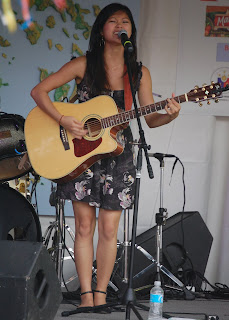Fil-Ams have often defied definition. They can be white, black or brown. Their looks are often confused with one or another race; they’re equally fluent in English as they are speaking any of a dozen Philippine dialects (some of which sound eerily like Spanish), and they’re equally adept in banks, laboratories and hospitals, as they are in America’s battlefields.


They are soldiers like retired Maj. Gen. Antonio Taguba, culinary artists like White House chef Cristeta Comerford, businesspersons and civic leaders like Loida Nicolas-Lewis, lawmakers like Ohio Congressman Steve Austria, bureaucrats like USAID executive Gloria Dino-Steele and inspirations like armless aviatrix Jessica Cox; they are scientists, accountants, engineers, journalists, entertainers, caregivers, nannies.
They are Americans who recognize and embrace their Filipino roots, celebrating it like what they did at last weekend’s 7th Asian Festival in Reston, Virginia.


The Philippines was the featured country this year.
The two-day festival is held in the summer under the auspices of the Thai Tennis Organization in America.
Obviously, it was established to promote tennis, but over the years, it’s become a mecca for the Asian-American community to showcase their culture in the Metro DC region, drawing as many as 20,000 visitors in a single day.
Ambassador Willy Gaa helped open the festival’s Philippine Village.
The Village featured a rich variety of Philippine arts and crafts, from fruit carvings by Paete food carvers to arnis demonstrations to folk dances like the tinikling and pandango sa ilaw.
Curiously, among the hottest selling items were the Manny Pacquiao and Cory Aquino T-shirts – faces that Fil-Ams have apparently chosen to become the emblem of Filipino aspirations.



Delegations from scores of Fil-Am organizations from as far north as New Jersey and as far south as Richmond, travelled hundreds of miles to join Northern Virginia’s largest Asian festival.
There were enough Fil-Am stage artists to fill two stages at the festival. After all, even before the exodus of nurses and teachers to America, there were the Filipino entertainers.

Alfa Garcia, a singer-songwriter from New York, was nine when her family immigrated to America.
She sings mostly about love and the pursuits of youth, but some of her songs delve on the struggles of a young Fil-Am searching for identity in the already diverse American landscape.
Indie rockers The Speaks has been recognized here as an Amercian band, even if it’s made up of Fil-Ams. They signed up with Warner Music (Asia) in 2005, and their video is often seen in MTV and MYX, among others.


Vocalist Raf Toledo put his spin on the Filipino rock anthem “Ang Himig Natin” (to see their performance, click here).
Stephanie Reese played Kim in the German production of Miss Saigon and portrayed Princess Tuptim in the King and I at the Palladium Theater in London’s West End.
The all-girls band Ivy Rose continues to leave its mark in the Metro DC entertainment scene.
Three members are sisters who learned to play musical instruments after their father, Tito, who like this writer is a product of the Salesian’s Don Bosco schools, transformed their basement into a makeshift music studio.


And they’re just a sampling of the pool of Fil-Am talents that weekend.
At the middle of the Philippine Village was a life-size plaster replica of the Philippine buffalo – the carabao.



In his "Our Town" column in the Manila Mail, community scribe Jon Melegrito wrote –
“Neglected for years after its much-heralded debut on Pennsylvania Avenue 12 years ago, it made a return engagement in 2003. Sporting a new look, it served as Philippine Festival Mascot for another two years, languishing thereafter in a Philippine Embassy basement.

“Hailed in the Philippines as “Pambansang hayop” (national animal) the slow-moving but gentle beast of burden performs like a 2,000-pound machine, forging through mud up to its belly and working continuously for years. Silent and docile, it never complains despite the oppressive heat.
“When my father moved our family to a farm in Davao in the 1950s, the first thing he did was to buy a carabao. He worked that beast all year round. Then one day he turned over the reins to me. At nine years old, I learned to plow the field the old fashioned way. I and the carabao bonded well.”
The carabao was resurrected and given a fresh coat of paint through the bayanihan efforts of Fil-Am stalwarts and volunteers from the Philippine Embassy.
It stands sturdy and strong, with a splash of colors that speaks as much about the Fil-Am community in America’s capital region.
But it has no name, and community leaders are hoping it will finally get one. Just like many Fil-Ams, it is searching for its unique identity.
No comments:
Post a Comment